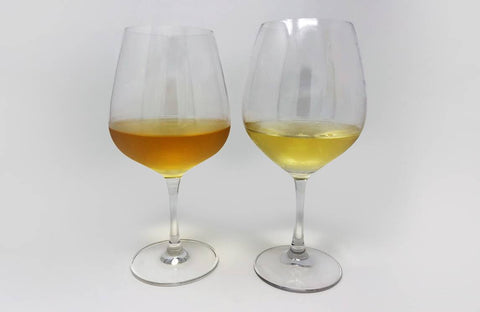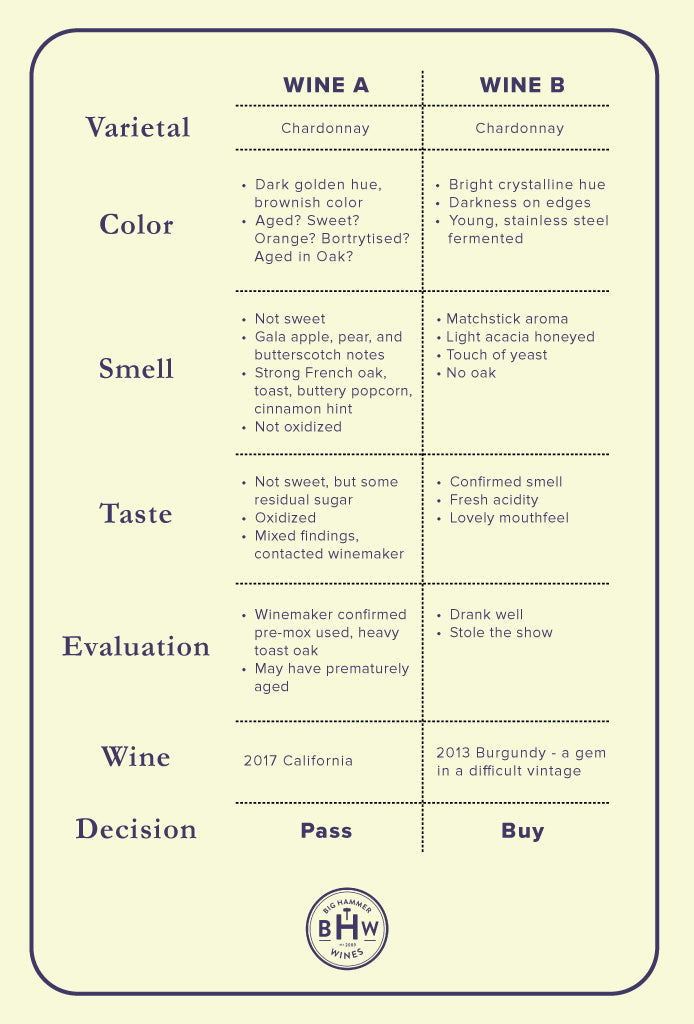
At Big Hammer Wines, we have the pleasure and opportunity to taste thousands of quality wines from around the world each year. With the goal of helping new wine drinkers understand and appreciate wine, we started our Insider Secrets series.
Learning how professionals assess the color of wine will change “how” and “what you drink” for the rest of your life. With “The Color of Wine,” we offer some insight into the process and mindset we employ to evaluate wines, using two white wines as examples.
An Introduction to Our Methodology
To some, our job sounds like paradise, but it is, in fact, work. After doing this job for more than twenty years, we’ve become incredibly perceptive at choosing the best wines. We select wines for our clients from an ever-increasing list of global contestants.
Our job every day is to judge wines, and we take it seriously. We want our customers to keep returning, ensuring the growth of our business. Offering only great wines representing good value keeps our customers happy.
We take several steps in determining a quality wine.
- Physical inspection
- Color
- Smell
- Taste
See our list of wine terms made easy.
Physical Inspection
We start with a physical inspection of the package, including the bottle, the label, the cork or closure, and the cap, if present. Big Hammer Wines offers online purchasing only, so the first visual impression is crucial. We will not cover the details of the physical inspection in this blog.
We’ll only see if the wine looks nice and appealing.
Color
If so, the next visual evaluation involves the color of the wine itself. In this example, we tasted two different white wines.

As you can see, the wine in these two glasses seem as if these are very different wines. In fact, both wines are made from 100% Chardonnay grapes.
The first major lesson about evaluating the color of wine shows that as wine ages, white wines get darker in color, while red wines get lighter.
Exposure to oxygen over time causes white wines to “oxidize” or get darker, then browner in color, like a sliced apple. For red wines, over time certain compounds interact with the tannins causing the wine to lose some color. Red wines can also suffer from oxidation turning red into brown.
Based on our initial visual inspection, the wine on the left (A) appeared to be much older than the wine on the right (B). The dark golden hue in Wine A, reminiscent of clover honey, combined with a brownish tint suggested an aged wine (possibly 10+ years old.) It also quite possibly indicates the wine is sweet.
The wine could even be an “orange” wine, which is a white wine made like a red wine, with extended skin contact during the fermentation process. It is during fermentation when the color is extracted from the skins. The longer the skins remain in contact with the juice, the darker the wine will be.
The wine might also be a botrytised, late harvest dessert wine like Sauternes. Botrytis cinerea is a type of fungus. It can rot the grapes in wet conditions. If the wet conditions alternate with dry spells, the fungus can be controlled and result in concentrated flavors and sugars.
The color of Wine A clearly suggests the wine was aged in oak barrels. A winemaker has numerous options when purchasing wine barrels. They come with different levels of toast: untoasted, light, medium, medium-plus, and heavy toast.
Think about the toast you make in the morning. The concept is the same based on how long your bread remains in the toaster. The color of wine will vary depending on the level of barrel toasting.
With glass A, we thought the wine was likely aged in a medium-plus toast barrel. Heavy toast is rarely used in white wine production.
The glass on the right (B) showed a much more common color of Chardonnay. A bright golden hue, crystalline, with only slight darkness around the edges. The wine didn’t appear to have been aged in oak, but did have more color than a young Chardonnay aged in a stainless-steel tank.
From the color alone, we assumed the wine was three to five years old.
Smell
The surprise came after smelling the wines.
Wine A was not a sweet wine, although it had fresh fruit aromas of Gala apple, pear, and butterscotch notes, typical in sweet wines. Sweet wines tend to exhibit these types of aromas.
As suspected, the wine smelled strongly of new French oak, with notes of toast, buttery popcorn, and a hint of cinnamon. The wine did not smell oxidized (a nutty burnt quality) although the color suggested otherwise.
Wine B had a reductive (matchstick) aroma that dissipated with a little bit of swirling, an indication of a certain style of winemaking. On the nose, it had a light acacia honey quality and a touch of lees, with no trace of oak or toast influence.
Taste
The taste of both wines confirmed what we had learned from our visual inspection and sniffing.
But, we were in for yet another surprise.
It turned out that Wine A was younger than Wine B. Wine A was a wine from 2017, while Wine B was from a 2013 vintage.
We were shocked. How could this be? We wondered what was going on.
We reached out to the winemaker. He confirmed that Wine A was made in a rich oxidative style (deliberately exposing the wine to oxygen) and was aged in heavy-toast barrels.
FYI, sometimes we taste blind, more as a parlor game to see who can correctly identify the grapes or region of the wine. Blind tasting is done to remove any indication of a wine’s origin, so the taster evaluates the wine on its own merits.
Our Evaluation
Wine A, a three-year-old wine, had a heavy dose of toasted oak and some residual sugar. We would expect it to have some darker golden color, but not the browning of oxidation.
It turns out many winemakers utilize a technique called “pre-mox,” which is short for premature oxidation, which can be risky. A little oxygen early in a wine’s life helps ready the wine for early drinking, but it can expose molecules that may brown over time.
However, those molecules, once oxygen binds to them, can be filtered out before bottling. Too much oxygen exposure at any point in a wine’s life causes an accumulation of acetic acid, the acid in vinegar.
Our Buying Decision
In the end, we bought the entire inventory of Wine B from the supplier at a stellar discount of 50% off the normal price.
We made this decision even though 2013 was not a great vintage in Burgundy, and a seven-year-old white wine is generally considered “old” by the market.
We bought it because Wine B continued to drink so well. Like many great white wines, as it warmed to 65 degrees and had been opened for 30 minutes, it went from strength to strength and stole the show. The wine had a fresh acidity that belied its age, and a lovely mouthfeel, no doubt due to stainless steel tank aging on the lees.
Lees are the dead yeast cells created during fermentation when live yeasts consume grape sugars, converting them into alcohol. Aging wine on the lees adds complexity and a feeling of more texture in the mouth.
While Wine A ended up going down the drain, we took Wine B home and polished it off with some chicken scallopini. It was fantastic!

The Big Reveal
See our amazing selection of Chardonnay!Big Hammer Wines
The wine experts at Big Hammer Wines taste thousands of wines every year from around the globe, looking for quality and value. This special offer reflects the passion we have for our clients.
Discover the world through its wines, Click Here! Visit Bighammerwines.com and become a wine expert!


